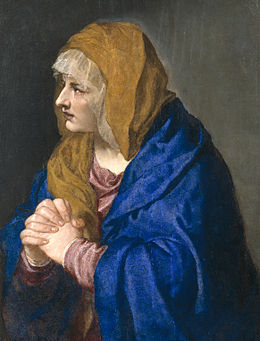
The Museo del Prado, officially known as Museo Nacional del Prado, is the main Spanish national art museum, located in central Madrid. It houses collections of European art, dating from the 12th century to the early 20th century, based on the former Spanish royal collection, and the single best collection of Spanish art. Founded as a museum of paintings and sculpture in 1819, it also contains important collections of other types of works. The numerous works by Francisco Goya, the single most extensively represented artist, as well as by Hieronymus Bosch, El Greco, Peter Paul Rubens, Titian, and Diego Velázquez, are some of the highlights of the collection. Velázquez and his keen eye and sensibility were also responsible for bringing much of the museum's fine collection of Italian masters to Spain, now one of the largest outside of Italy.
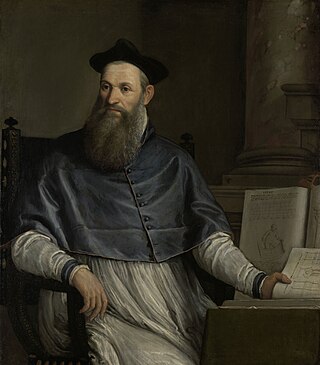
The Portrait of Daniele Barbaro is a painting by the Italian Renaissance master Paolo Veronese in the Rijksmuseum Amsterdam. Daniele Barbaro was a member of the Venetian aristocracy. He was an important prelate, humanist and architectural theorist, who commissioned a number of works from Veronese. Veronese had been involved directly with Barbaro and his brother Marcantonio Barbaro, decorating the Villa Barbaro, Maser, which Palladio designed.
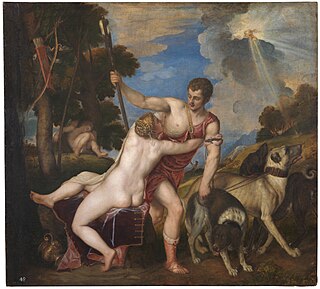
A composition of Venus and Adonis by the Venetian Renaissance artist Titian has been painted a number of times, by Titian himself, by his studio assistants and by others. In all there are some thirty versions that may date from the 16th century, the nudity of Venus undoubtedly accounting for this popularity. It is unclear which of the surviving versions, if any, is the original or prime version, and a matter of debate how much involvement Titian himself had with surviving versions. There is a precise date for only one version, that in the Prado in Madrid, which is documented in correspondence between Titian and Philip II of Spain in 1554. However, this appears to be a later repetition of a composition first painted a considerable time earlier, possibly as early as the 1520s.

The Worship of Venus is an oil on canvas painting by the Italian artist Titian completed between 1518 and 1519, housed at the Museo del Prado in Madrid, Spain. It describes a Roman rite of worship conducted in honour of the goddess Venus each 1 April. On this occasion, women would make offerings to representations of the goddess so as to cleanse "every blemish on their bodies".

Equestrian Portrait of Charles V is an oil-on-canvas painting by the Italian Renaissance artist Titian. Created between April and September 1548 while Titian was at the imperial court of Augsburg, it is a tribute to Charles V, Holy Roman Emperor, following his victory in the April 1547 Battle of Mühlberg against the Protestant armies.
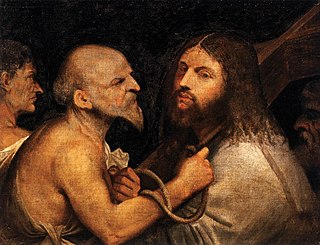
Christ Carrying the Cross is an oil painting attributed to either Titian or Giorgione. It is dated to about 1505. The painting is housed in the Scuola Grande di San Rocco in Venice, Italy. There are several later versions of the subject by Titian.
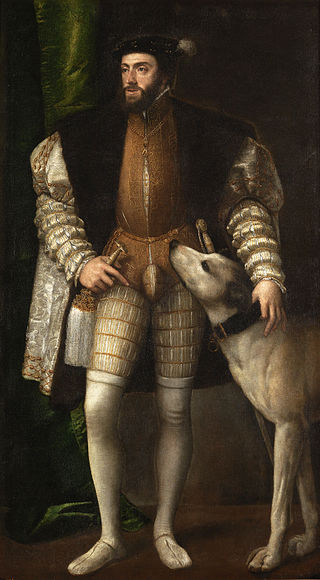
The Portrait of Charles V with a Dog is a portrait of Charles V, Holy Roman Emperor with a hunting dog, painted by Titian in 1533. It passed from Charles to the Spanish royal collection, from which it passed to the Museo del Prado in Madrid.
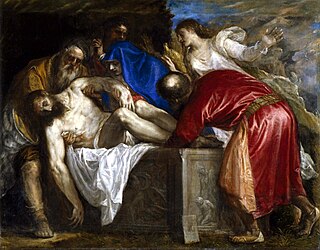
The Entombment is a 1559 oil-on-canvas painting by the Venetian painter Titian, commissioned by Philip II of Spain. It depicts the burial of Jesus in a stone sarcophagus, which is decorated with depictions of Cain and Abel and the binding of Isaac. The painting measures 137 cm × 175 cm and is now in the Museo del Prado in Madrid. Titian made several other paintings depicting the same subject, including a similar version of 1572 given as a gift to Antonio Pérez and now also in the Prado, and an earlier version of c.1520 made for the Duke of Mantua and now in the Louvre.
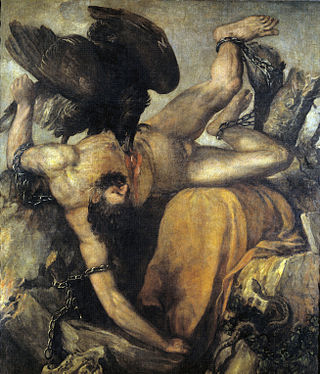
Tityus is a mythological painting by Titian dating to 1549 in the Museo del Prado, Madrid. It shows the punishment of the giant Tityos from Greek mythology.

Alfonso d'Avalos Addressing his Troops is a portrait of Alfonso d'Avalos by Titian, painted in around 1540 and now held at the Museo del Prado in Madrid, Spain. Alfonso d'Avalos, Marquise del Vasto, was a noble Neapolitan, descended from a family of Castilian origin. He participated in the Battle of Pavia and the conquest of Tunis in 1535. In 1538 he was appointed governor of Milan. Military failures caused a subsequent falling out of favor with the Emperor Charles V.

St Margaret and the Dragon is a c.1559 painting by Titian of saint Margaret the Virgin; it is now in the Museo del Prado in Madrid.

Portrait of Federico II Gonzaga is a painting by Titian, who signed it Ticianus f.. Today in the Museo del Prado, Madrid, it portrays Federico II, Duke of Mantua who married in 1529; the portrait may have been commissioned for the occasion. The dog, a Maltese, is a symbol of faithfulness.
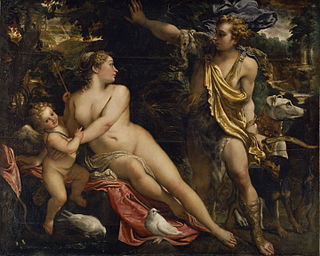
Venus, Adonis and Cupid is a painting created c. 1595 by Annibale Carracci. The painting is in the Museo del Prado, Madrid. Annibale Carracci was one of the most well known Italian Baroque painters of the seventeenth century. The Carracci brothers established an academy of art called Accademia degli Incamminati, which pioneered the development of Bolognese Painting. Annibale Carracci and Caravaggio were among the most influential artists of this century, who through their unique artistic styles led to the transition from Mannerist to Baroque. Annibale was born in Bologna in 1560 and died in Rome in 1609.

The Fall of Man is a painting of the Fall of Man or story of Adam and Eve by the Venetian artist Titian, dating to around 1550 and now in the Prado in Madrid. It is influenced by Raphael's fresco of the same subject in the Stanza della Signatura in the Vatican, which also had a seated Adam and standing Eve, as well as Albrecht Dürer's engraving Adam and Eve for smaller details. Owned at one point by Philip II of Spain's secretary, Antonio Pérez, and perhaps first commissioned by his father, in 1585 it entered the Spanish royal collection, where it was copied by Rubens between 1628 and 1629 for his own version of the subject.

The Crowning with Thorns is a 1618–1620 painting by Anthony van Dyck. He produced it aged 20 during his first Antwerp period, when he was the main studio assistant and pupil of Peter Paul Rubens. It shows Rubens' influence in its relatively sombre palette, chiaroscuro and highly realistic portrayal of musculature. He seems to have completed it early during his stay in Italy, since it also shows the influence of Titian and other Venetian painters in Jesus' face.

La Gloria is a painting by Titian, commissioned by Charles V in 1550 or 1551 and completed in 1554. It was first given this title by José Sigüenza in 1601 — it is also known as The Trinity, The Final Judgement, Paradise, and Adoration of the Trinity.

Ixion is a 1632 oil painting, signed and dated by Jusepe de Ribera. It shows a scene from Classical mythology, of Ixion being tortured as the eternal punishment meted out by Zeus. It is one of a series of four paintings by Ribera of the four "Furies" or "Condemned" from Greek mythology. It is held by the Museo del Prado in Madrid, along with Ribera's painting of Tityos; the other two, of Sisyphus and Tantalus, are lost.
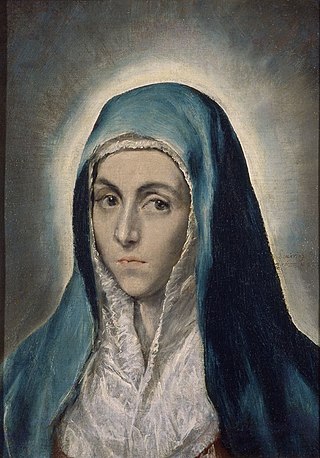
The Virgin Mary, also known as Mater Dolorosa, although this title is now considered misleading, is a late 1590s or early 1600s painting by the Greek born, Spanish Mannerist painter Doménikos Theotokópoulos. It is on display in the Musée des Beaux-Arts of Strasbourg, France. Its inventory number is 276. A similar looking canvas in the Museo del Prado is considered a weaker replica.

Salome, also known as Salome with the Head of John the Baptist, is an oil painting by the Venetian painter Titian, made in about 1550, and currently in the collection of the Museo del Prado in Madrid. It is not to be confused with other compositions of Salome and Judith by Titian.
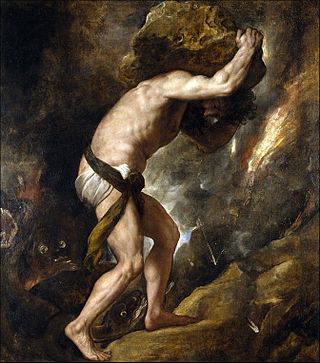
Sisyphus is an oil painting by the Venetian master Titian, made in 1548 or 1549. It is in the collection of the Museo del Prado in Madrid.
